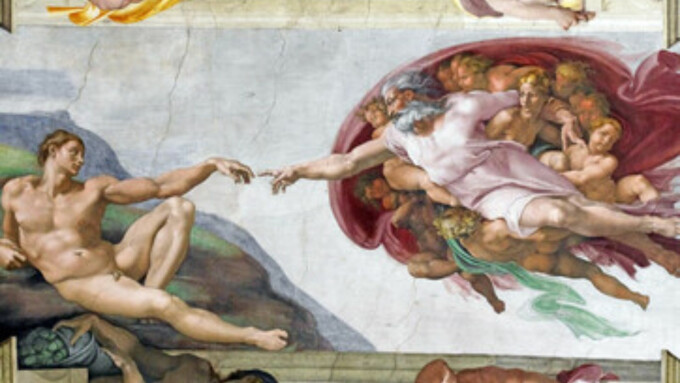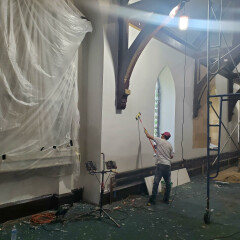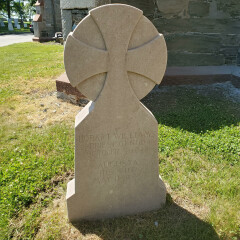It is for us to independently and quietly listen.

At this past Sunday (6.12) morning’s outdoor service, our rector, the Rev. Jennifer Pedrick, shared the reality of God’s spiritual messages in our lives; it struck me this might be a good time and theme to write a bi-weekly report on the restoration work. Moses was lucky, he had a burning bush speak to him. The rest of us mortals live today in a modern world where messages are flashed on our phones, computer screens, and into our lives and brains faster than we can comprehend them. However, it is for us to independently and quietly listen, as shared Sunday, so that the soft spiritual voice can help us complete our task correctly.
We are now into the second month of the restoration of the historic St. Mary’s Church with process and budget still on track.

The most major work has been on the walls and ceiling. The plaster cracks have all been repaired, and two coats of plaster have been applied. This will ensure that the cracks, some of which involved whole sections of the walls and ceiling, as was evident from the picture, do not return when the walls and ceiling are painted. Where the wall had severely deteriorated, new wall board was applied and rotted wood was replaced. All of this prep work is intended to give the entire church an updated plaster finish while saving the old plaster where possible.
The walls, beams and other wood finishes are now getting their final sanding. When the sanding is finished and everything is dust-free, the primer paint coat will begin perhaps as early as next week, and color will then follow on the walls and ceiling, moving from the front of the church to the rear. The expected completion date for the painting is by the end of July.
We are now starting the review of colors for the interior: pew cushion fabrics, chair coverings, carpet, wall paint and ceiling paint. Because of supply chain delays, the pew cushions can take 16 weeks for completion and installation. So, a color and fabric decision soon are paramount.
Patti Watson of Taste Design, Inc, and I met on Thursday (6.16) with the vestry to see the first cut on color and fabric. Later in the summer, Patti will share with those of the congregation who may be interested the palette of color, fabric and rug chosen.
For me, color will be the critical pathway to success or failure for this restoration project. It could be a future where everyone while sitting in their new comfortable pews seeking spiritual meditation, may only receive signals of wrong color choices! Or, if we are thoughtful enough and we have the right independent review after using expert artistic colorists and interior designers, God will share his answer to our prayers, “What colors/shades are right and help us to get it right!” When this act of faith happens, the congregation will have once more that sought-after renewed worship place of spiritual beauty and genuine satisfaction for religious services, wedding and funeral service.
In the Italian countryside, just outside of Siena, in a small village called Pievescolo among the beautiful fields of sunflowers and blue sky is a villa, now a hotel, called La Suvera. In 1508, it became the summer home of Pope Julius II. According to the story, it was here that Pope Julius II summoned Michelangelo, to both paint the ceiling of the Sistine Chapel of the Vatican and create the sculptures for the Pope’s future tomb.
Michelangelo, up to this point in his artistic career, had only done sculpture, not fresco painting, on the scale contemplated by the Pope. As one can imagine, Michelangelo was very concerned he was not up to the task but the Pope insisted. At the same time, Raphael was painting the Pope’s ante-chamber apartment with the beautiful murals that adorn it today. This no doubt led to more anxiety for Michelangelo. But as we know, Michelangelo climbed the scaffoldings daily from 1508 until done in 1512, in answer to the Pope’s call to create what even Raphael pronounced when he first saw the ceiling, the most incredible art ever painted. When one sees the Sistine Chapel ceiling today, one knows that truly God had to have blessed Michelangelo, as it is doubtful any human could have painted such a masterpiece without God’s help and blessing.
This story and the concern for the color selection for our church is shared, not with the intent of comparing our church and its finish to the Sistine Chapel, but as an appeal congregation-wide for prayers that with God’s spiritual help, along with the input of experts, our rector and the oversight of the vestry, that the right finish colors for this restoration project are selected. Finally, we need prayers that we do appropriately restore this beautiful church with the financial generosity of the congregation to the finish that we all so earnestly hope and seek. This restoration is not an easy task as each individual and family has a vision of just how the church should look and feel when finished. This vision is developed over years of worship, prayers offered inside, weddings and funerals. However, this is not of course, just the restoration of any building, it is the restoration of God’s house, and we certainly ought to use His spiritual input to get it right.
Later this week, we will also select the mortar color for the exterior re-pointing. This is another difficult decision, as there must be at least four different mortar colors on the exterior of the building from various repairs over the years.

The very first rector of St. Mary’s, the Rev. Hobart Williams’s burial stone and grave are located adjacent to the church on the south side. It can be seen as one drives up the drive to the parking lot. It has a rounded rose-colored top. He arrived in southern Portsmouth in 1843, when he said “there was nothing here but an old wooden shed.” He served as the rector as the plans of Sarah Gibbs were made for the current St. Mary’s Church.
In fact, he and his wife, the former Augusta M. Eaton, the daughter of a clergyman in Boston, lived with Sarah Gibbs in her house at Oakland Farm, now condominiums for many years after their first arrival in Portsmouth. Finally, when Sarah Gibbs died at age eighty-two in 1866, they had no place to live, as she had only a life estate in the Oakland Farm property. So, he paid for the restoration of a manse on the church property from his own money and lived there for the remainder of his ministry and life. The Rev. Hobart Williams served 41 years as the first rector and missionary of St. Mary’s Church. He was beloved and when he died in 1884, although the Episcopal Diocese of Rhode Island had given he and his wife a life tenancy in the manse he had remodeled, his wife deeded back any interest that she had after his death and went to live with other family members.
Now the Rev. Hobart Williams must look up at the ongoing restoration and the new masonry and smile just as Sarah Gibbs may, knowing how significant St Mary’s Church has been in the lives of the congregation during the past 175 years since that cornerstone was laid on September 2, 1847. He also went to his grave knowing where the cornerstone was positioned, but never wrote the location down. The exact location of the cornerstone remains a mystery today; however, we continue to look for it. The cornerstone has a hollowed space covered with a copper plate and contains inside a Holy Bible, Book of Common Prayer, Journal of the RI Convention and Church Almanac for 1847, and one number of the Missionary and Gospel Messenger (whatever that may be?). If found, it will be a great reason for celebration as part of the completion of this restoration project.
Thank you for your continued financial support and perhaps more important, your anticipated prayers that we get colors and the restoration right. Anon!